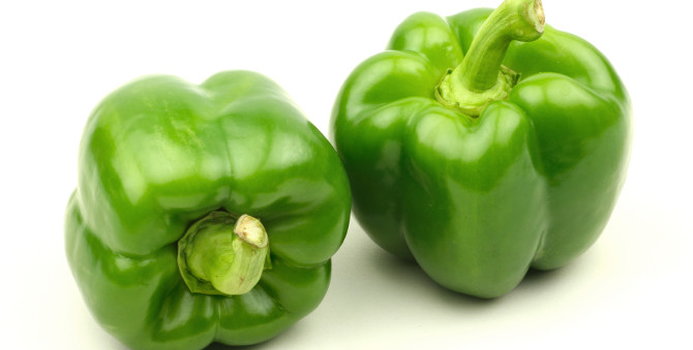A green pepper is a highly nutritious vegetable. This bell shaped vegetable with a green, glossy exterior adds a dash of color to any dish. It is also referred to as a bell pepper. It has a tangy taste that enhances food flavor. The inside has a small, white foam-like core with tiny seeds attached to it. This pepper isn't "hot" due to the absence of capsaicin which gives pepper the characteristic "hot" taste. Orange, yellow and red variants also exist. The pepper is packed with nutrients. It is a good source of vitamins, minerals and phytochemicals.
One cup of chopped green pepper, about 150 grams, has 30 calories. It provides the following nutrients:
- Protein - 3 grams
- Dietary fiber - 10 grams
- Vitamin A - 11 percent of recommended daily value
- Vitamin B1 - 7 percent of recommended daily value
- Vitamin B6 - 20 percent of recommended daily value
- Vitamin B9 - 5 percent of recommended daily value
- Vitamin C - 200 percent of recommended daily value
- Vitamin K - 14 percent of recommended daily value
- Iron - 0.5 micrograms
- Magnesium - 14.9 micrograms
- Phosphorous - 30 micrograms
- Potassium - 260 micrograms
- Calcium - 14.9 micrograms
The vegetable can be eaten raw or cooked briefly. It makes a wonderful addition to most salads. It can also boost your health in various ways.
Antioxidant Properties
Various vitamins and phytochemicals found in green peppers have antioxidant properties. The peppers contain vitamin A in the form of carotenoids as well as vitamins B6, B9 and C, all of which are powerful antioxidants. These vitamins play a vital role in neutralizing free radicals in the body which have the capacity to cause serious damage to cells during their roaming activities. Free radicals also contribute to the build-up of cholesterol in blood vessels which increases the likelihood of stroke and heart disease. Besides their antioxidant properties, phytonutrients in green peppers play an anti-inflammatory role. This gives relief from pain and inflammatory conditions. It makes bell peppers a useful dietary item if you have rheumatoid arthritis or osteoarthritis. Phytonutrients also help to relax the airways and reduce wheezing in asthma cases.
Cardiovascular Health
Green peppers are a rich source of vitamin C. They contain double the vitamin C content of oranges. Green peppers are also rich in flavonoids and phytochemicals. These reduce the formation of blood clots, thereby lowering the risk of stroke and heart attack. The pepper is also a good source of vitamins B6 and B9 which reduce levels of homocysteine, a toxic by-product of biochemical processes in the body. High levels of homocysteine can damage blood vessels which increases the risk of stroke and heart attack. Vitamins B6 and B9 convert homocysteine into beneficial molecules which provides more safety for blood vessels.
Colon Health
If you want to promote the health of your colon, fiber is a vital element in the diet. Luckily, green peppers are loaded with fiber. Fiber reduces the degree of exposure of colon cells to bacteria and toxins. This is because it speeds up the transit time of waste matter through the gut. Research has shown that vitamins A, C and B9 significantly reduce the risk of colon cancer. Green peppers are an excellent source of these vitamins.



